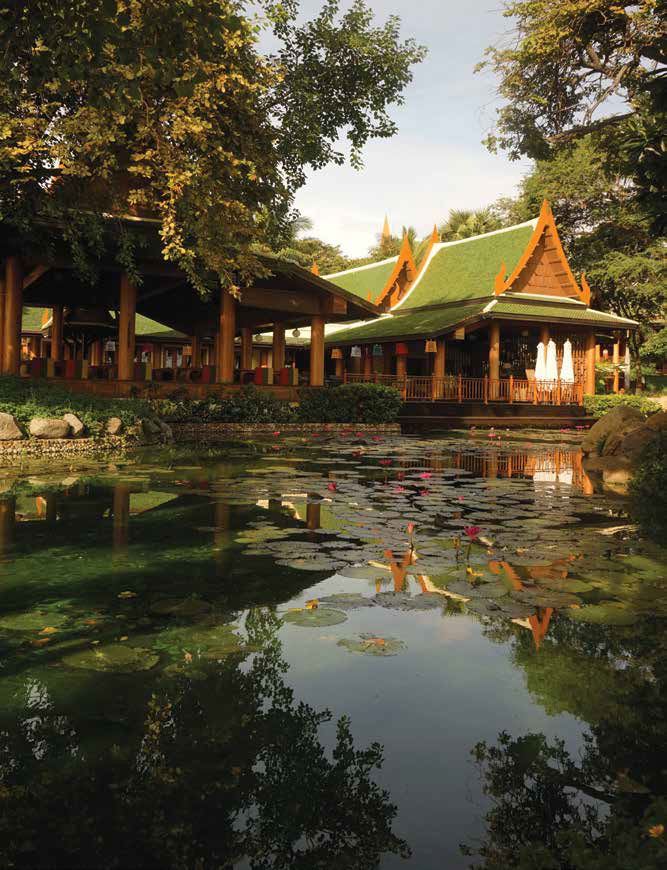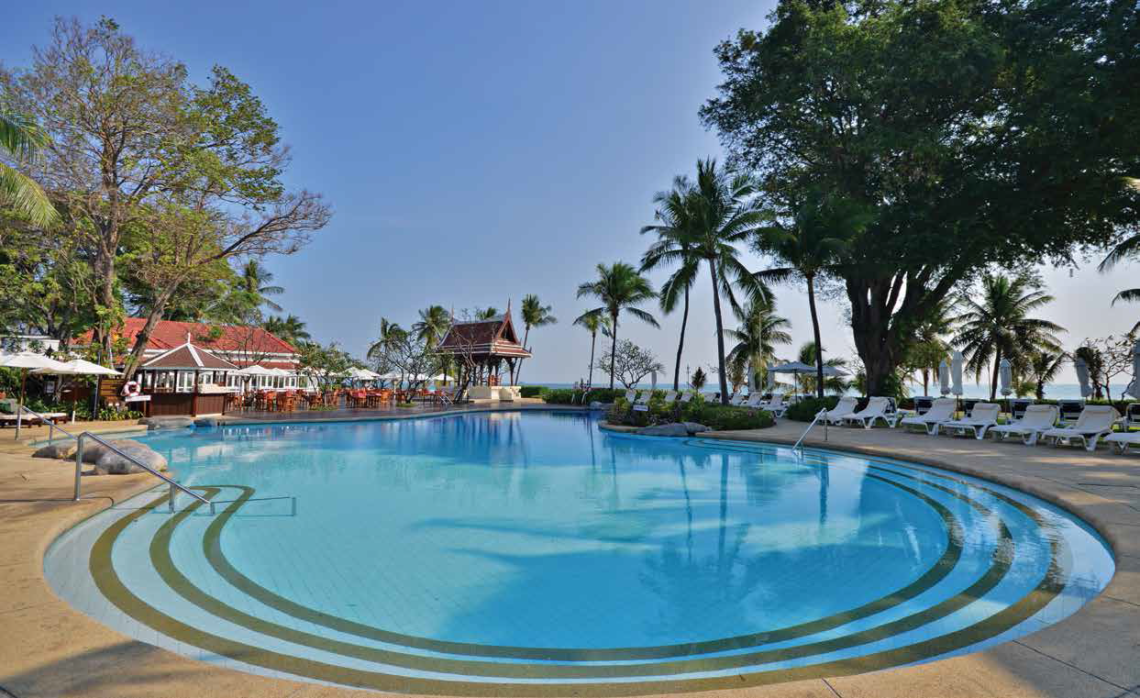Conceived and built by royals, Hua Hin, on the Gulf coast of Thailand, can truly be called the resort of kings. Writer Steve White.


Conceived and built by royals, Hua Hin, on the Gulf coast of Thailand, can truly be called the resort of kings. Writer Steve White.

In a country that reveres its kings, Hua Hin has more reason than most places to feel close to the monarchy. The seaside town on the Gulf of Thailand, 200km from Bangkok, might have remained just another fishing village if not for them.
At the turn of the 20th century, it was a tiny place called Samor Riang, meaning ‘row of rocks’. Back then, to build railways was to be modern so King Chulalongkorn (Rama V) and his son King Vajiravudh (Rama VI), did just that in 1911, when the town was renamed Hua Hin, or ‘stone head’ after an outcrop offshore. Despite the development, it remained an uncomfortable stop on the way south – you could just get there quicker – so in 1921 came its first hotel: the august and aptly-named Railway Hotel, built by Prince Purachatra, director of State Railways.
“It is time to provide holidaymakers with more comfort and convenience than before since it is very costly and inconvenient for people to have to prepare their own lodgings, facilities and servants themselves,” explained the Prince.
Officially opened on January 1, 1923, the resort boasted a fine dining restaurant with a European manager and room service, a real rarity in those days. All that remained was for Rama VI to commission a 3,000-yard golf course, designed by a railway engineer and dropped in a short nine-iron from the station platform and Hua Hin had its start.
Today these three institutions – the station, the hotel and the golf course – remain central to Hua Hin’s tourism.
Of the three, the station has changed the least. A handsome new building put up in 1926 that borrowed heavily in style from the hotel, still stands today. And if the rolling stock has less panache, the arrival of a train still brings a little ripple of excitement on the platform, not least because the state of the national railways is such that any arrival is something of an event.
In a sign of just how frequent delays are, in the booking office, on the other side of the ticket window from a lovely old printed schedule that looks to date back several decades itself, is a whiteboard showing the expected length of delays. Updates pass unremarked by stoic locals, while most visitors using this elastic service seem to have sensibly decided to label it ‘sightseeing’ rather than strictly a form of transport. Outside, a pair of carriages have become a simple public library that makes up for its limited stock by being an air-con refuge if the day’s heat is oppressive.
As for the Railway Hotel, it is now the Centara Grand Beach Resort and Villas, sitting smack in the centre of town. As the name suggests, it has been much extended over the decades but always in keeping with the colonial style of the core building built by Prince Purachatra.

Even though two royal palaces were also built in Hua Hin in the 1920s – the beachside Maruekatayawan, and Klaikangwon, residence of the current King Bhumibol Adulyadej and Queen Sirikit – the Thai Royal Family have remained regular visitors to the Centara Grand.
“Our hotel and H.M. the King and Queen and the Palace have a long and intimate connection,” says present GM, Peter Nilsson, of the royal connection. “Centara Hotels and Resorts has a further very special relationship with H.M. the King which was last year reinforced with the bestowing of the Royal Garuda emblem on top of our hotel, which is considered one of the highest honours in Thailand.”
Also bearing a regal imprint today is that original golf course, now called the Royal Hua Hin and just one of seven courses in the area. That fuelled a rise in specialist golfing vacations, while memberships have swollen as foreign retirees have settled in the area.
If more active pursuits are your thing though, there are plenty of places that rent bikes: from hotels offering basic rides for round town; to places like Velo, in Hua Thanon, with full-on road racers and downhill machines plus all the necessary kit.
The popularity stems from yet another royal connection. In 2015, Crown Prince Maha Vajiralongkorn, next in line to the throne, led two huge mass rides: Bike For Mum, on the Queen’s 83rd birthday, and the even larger Bike For Dad on the King’s 88th. An estimated 750,000 people in 70 cities worldwide rode in the latter and Thais with disposable income seem to have caught the biking bug.
Out on the water, kitesurfing has yet to receive the royal seal of approval, but the King and Queen of Thai kiting hail from this stretch of Gulf coast. Narapichit ‘Yo’ Pudla has several Men’s titles to his name on the KTA (Kiteboard Tour Asia) tour, while Fon Benyapa Jantawan has claimed a number of victories on the women’s tour.
Conditions are excellent from October to May, with side-shore breezes making for a safe learning environment – just check when choosing a kiting operator that they have internationally-recognised credentials. When the beach breeze isn’t working, there’s also good wind on the reservoir behind Pranburi Dam, and if even that isn’t cranking then there’s a cast-iron guarantee of kiting time at the cable park, also in Pranburi.
Back a little ways north, on the Hua Hin side of the rocky headland of Khao Takiab, sits another hotel with a royal connection: the Hyatt Regency. The connection is courtesy of a Dr McFarland, a dentist and Dean of Thailand’s first medical school in the early decades of the 20th century, as well as publisher of the first Thai-English dictionary and manufacturer of the first Thai typewriter. After long service to the country, the doctor was granted some land in Hua Hin where he built a holiday home. In 2006, that land was bought by Hyatt who have reworked the building while keeping its overall form and original timber floor.


OPENING PAGE: End of a perfect day. TOP LEFT AND ABOVE: Scenes of the Hyatt Regency Hua Hin. BELOW AND BOTTOM LEFT: The Centara Grande main pool and Coast restaurant; Elephant Bar


McFarland House, as it is now called, is the restaurant for The Barai, the Hyatt Regency spa that has dedicated villa-style rooms and a pool too. The Barai is inspired by the temples of Angkor though the formality is undermined with playful touches. Here, in a hotel within a hotel, guests are pampered and pummelled, soothed and stretched. Yoga classes are outdoors, either alongside the striking pool, a severe concrete slash angled at the sea, or under the frangipani tree on the lawn beside McFarland House.
In July 2016, The Barai launched its Lifestyle Collection: customised three-, five- or seven-day programmes that address fullbody health through directed exercise, quality rest and relaxation, and healthy eating. The programmes are bookended by consultations to set appropriate goals and discuss progress.
Therapy of a different kind can be found right next door. The Hyatt Regency is a 15-minute songtheow ride from downtown, but for those missing street food and souvenirs, at the weekend, the market comes to you. It’s called Cicada and it’s parked right outside the hotel gates, pulling in tourists from up and down the strip for live music, arty keepsakes and an eclectic selection of food, Thai and otherwise. Crash on the grass with a cocktail and a cushion and surrender to the relaxed vibe.
Overall, Hua Hin has a surprising range of international food thanks to the town’s foreign retirees, but visitors should focus first on what’s most local, which is to say, seafood. Every evening the sea is studded with squid boats and their produce is visible all around town. Much of it ends up at another famous market that sprawls out from the station. Here, every evening, touts noisily vie to draw tourists to streetside restaurants while the throng bustles between stalls selling roti and satay, kebabs and biriyani, as well as staples like papaya salad, pad thai and young coconuts. Locals may sniff at the prices and uneven quality but for visitors it’s convenient and cheap. Snack from stall to stall, or pull up a stool and plump for a full meal. Wherever you find yourself, you can eat like a king and all not much further than you could lob a lobster from the station that started it all, less than a century ago.

Edwin’s Ark
A guidebook to Hua Hin of the early 20th century suggested that, “in addition to the excellent sea bathing, one may shoot leopards, deer, hares and doves”. Happily, most visitors expect a very different relationship with wildlife these days, and the Wildlife Friends Foundation of Thailand (WFFT), a half-hour north-west of Hua Hin, is a trendsetter in this regard.
The brainchild of a Dutch former special forces soldier, Edwin Wiek, it was set up in 2001 on land donated by the neighbouring Wat Khao Look Chang temple. Today its enclosures hold more than 500 animals – ranging from sun bears and macaques, to iguanas and a cassowary – who have been rescued from, or surrendered by, owners not prepared to look after them any longer.
While the otters are adorable and the gibbons have to be heard to be believed, the undoubted stars are the elephants. Elephant rides have been a staple of Thai tourism for donkey’s years but since the suffering the animals endure in their ‘training’ has been exposed, this former money-spinner has become an embarrassment. Now a number of these giants, some formerly used in tourism and others used in logging, get to live out the remainder of their lives, chain-free and in stimulating surroundings.
Only those animals least changed by their exposure to man have any chance of a return to the wild, and are kept further from visitors, while the more ‘imprinted’ animals are allowed to engage with humans. It’s intellectually enriching for both parties and raises valuable funds to help the centre continue its work.
























